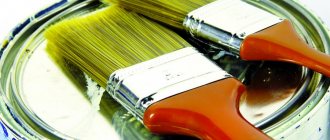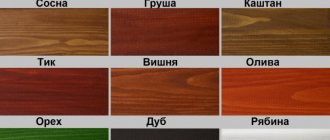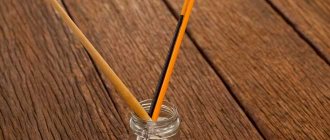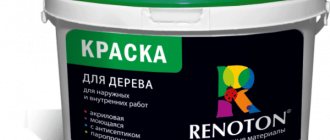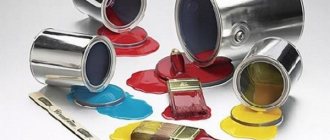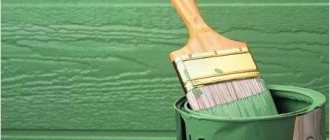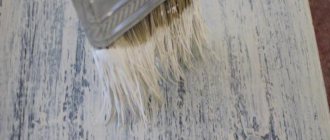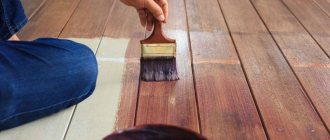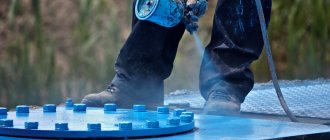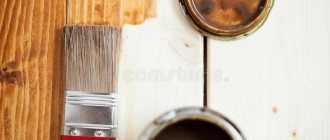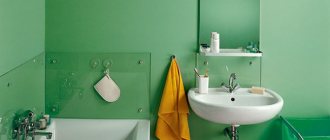Characteristics of waterproof paint
Manufacturers try not to include harmful chemicals in paints. Dyes contain polymer compounds and some auxiliary components.
Moisture-resistant paints have the following properties:
- They do not dry quickly, at least 20 hours;
- Some types of paints are resistant to ultraviolet rays;
- Do not fade in the sun;
- They withstand various environmental influences, so they can be used for external painting;
- Some dyes have antifungal protection.
Pros and cons of waterproof paint
Moisture-resistant paints have a number of advantages:
- Wide range of colors;
- Eco-friendly;
- Perfectly masks small defects on walls;
- Easy to apply to any surface;
- Do not deteriorate in aggressive environments;
- The coating is hygienic.
Dyes also have some minor disadvantages:
- Before coating, the walls must be leveled, since large defects will not disappear;
- Condensation may appear because the substance has low vapor permeability;
- Walls can only be painted at positive temperatures above 5 degrees.
Suitable paints for the bathroom
Types of bathroom paints must have the following characteristics: resistance to moisture, safety, so that mold and mildew do not form due to dampness.
The most common are dyes with micropolymer compounds diluted with water. The cost of such paints is low.
In fact, water-based bath paints can be divided into:
- Oily;
- Silicone;
- Acrylic;
- Silicate;
- Alkyd;
- Chlorinated rubber.
The most expensive are silicone dyes; they have high quality characteristics. Acrylic and silicone paints are great for bathroom walls. They form a protective film on the surface and prevent moisture from accumulating and fungus developing. The paints contain no harmful substances to the human body, they are not poisonous, and dry quickly.
How to save money on bathroom renovations?
When do you choose paint as the main material for wall decoration? Usually in two cases: if you need to quickly make the bathroom as comfortable as possible or to save the family budget.
The second option is more common. Indeed, the cost of bathroom paint is low, as is its consumption, so the actual painting costs a relatively small amount.
However, do not forget about the preliminary preparation of the surface - sometimes you need a reliable primer or even plastering of the entire area - in this case, costs increase.
If you have brick walls or need to level out the old coating, you will need plastering. Only an experienced plasterer can independently prepare the solution and level the walls, so surface preparation is often more expensive than the final stage - painting
The ideal option for painting is smooth, pre-plastered walls. Repair work in a small bathroom (the standard in panel houses is from 2.2 m²) will take no more than one evening, and the cost of materials together with tools will amount to 3-4 thousand rubles.
For comparison, inexpensive tiles will cost at least 20 thousand rubles, and if you have insufficient experience in laying tiles, you will need the skills of a professional, and that’s about another 20 thousand rubles.
It turns out that painting the walls yourself is the most profitable and fastest way.
Using various combinations, you can even divide a small room into zones: the wall near the bathtub is lined with white tiles, the rest of the area is covered with bright paint
It is not difficult to calculate the amount of paint for a specific room - usually the consumption is indicated in the instructions posted on the can.
But remember that for a durable, high-quality finish you need 2-3 layers plus 20-25% of the total, as they say, just in case.
Most often, a specially selected color is used, so it is better to purchase the material with a reserve, otherwise problems may later arise with the selection of a similar color (or the store will not have the necessary material for tinting).
About saving time in the following video:
Characteristics of oil paint
This is the cheapest option for painting surfaces. It is created on the basis of synthetic oils or drying oil.
The insolubility of mineral particles requires the paint to be thoroughly mixed before use.
The advantages include:
- You can paint on wood and metal;
- Does not allow moisture to pass through;
- The result is a smooth surface;
- Good adhesiveness.
There are more disadvantages:
- Strong smell before drying, takes a long time to dry (24 hours);
- The fumes are harmful;
- The color changes over time;
- It fades from the sun's rays;
- In places where water gets in, it begins to crack and peel.
This coating will have to be renewed every year, so it is not recommended to use oil paint in the bathroom.
Painting walls - step by step instructions
The easiest way is to paint the walls one color. To prevent the product from getting on the ceiling and other surfaces that cannot be painted, they are protected with masking tape.
After this, perform the following steps:
- The paint is mixed until a homogeneous consistency is obtained. The film that appears on the surface is removed, trying to prevent its particles from getting into the composition.
- The finishing material is tinted. Pigment is gradually poured into the container with the water-based solution, stirring the product with a mixer. When the color becomes uniform, add the remaining color. The solution is stirred again. When using oil paints, this step is skipped.
- Paint corners and hard-to-reach places with a narrow brush. The paint is rubbed in, removing stains and drips. The tool must move in one direction.
- Use a roller or wide brush to paint large surfaces. Do not completely immerse the instrument in paint. The roller is rolled out onto a relief tray, removing excess finishing material. The coloring agent is applied in even stripes from top to bottom. Painted walls are allowed to dry for 6-36 hours.
- Carry out the procedure again, after which the masking tape is removed. This stage can be postponed to a later period, but it is advisable to complete it immediately. If the painted walls have stripes or stains, apply a third layer of finishing product.
Silicone water emulsion
The paint is odorless and easy to work with. It has its own positive characteristics:
- Fits well on any surface, even stone and concrete;
- A perfectly flat surface is not needed; it can hide some unevenness;
- Can be used at any temperature;
- The paint layer retains water but allows air to pass through, so it can be called breathable;
- Fungi and mold do not form;
- Easy to clean;
- Not afraid of sunlight.
Minus the cost, expensive paint. But this is compensated by the service life (25 years). It is better not to apply it to a metal base, as the vapors activate the formation of rust.
How to paint bathroom walls
The best paint for the bathroom is water-dispersion based on latex or acrylic. It lasts a long time in damp rooms and lays evenly on the wall.
You can buy this paint in any color in the OMA online store and construction houses. Also, in many stores in our network they will do tinting for you free of charge - they will select the desired shade if you have not found the right color.
In addition to water-dispersion paint, you can use latex or silicone paint. They are good because they protect the walls from dirt and do not let water through.
We've decided on paint for the bathtub. The best option is water dispersion.
What is important to know in advance
- To prevent the paint from falling off and hiding unevenness, prepare to apply three coats to the wall.
- It is better to buy light paint for a small bathroom. Bright colors will visually enlarge the room.
- Drops of water are clearly visible on the dark paint. It is better not to use black, burgundy and other similar shades.
- Use glossy bathroom paint if you have perfectly straight and smooth walls.
- Matte paint will hide unevenness after plaster or putty. True, it is easy to scratch or beat.
- You can find relief paint on sale. It will hide slight unevenness and just one layer will be enough. True, such a composition costs several times more than ordinary water-dispersion paint.
Water-based acrylate paint
If we talk about which bathroom paint is better, then it is acrylic. It has the most optimal properties:
- Slightly perceptible odor when drying, and then disappears completely;
- Resistant to moisture;
- Possesses vapor permeability;
- Adheses well to the surface;
- Can be used at any temperature, suitable even for a bath;
- Does not fade, is not afraid of UV rays;
- Eco-friendly.
A wide range of paint colors retains brightness for a long time.
The disadvantage is that the paint takes a long time to dry and the walls need to be prepared for painting. If you choose acrylic paint, then you need to know that when changing paint you will have to completely remove the applied acrylic layer.
Decorative painting methods
Not every person has artistic talent, so special tools are used to create unusual designs.
Using stencils
Disposable stencils are made from vinyl and supplied with an adhesive base. Acrylic templates are intended for long-term use.
Painting walls using stencils is done as follows:
- Apply the base tone in the standard way. Choose a pattern and determine its location.
- Remove the protective film of the stencil and apply the template to the wall. If there is no adhesive layer, the instrument is fixed with masking tape.
- Saturate the roller with paint, removing excess. The cutouts are painted evenly. Move the stencil, continuing to create the pattern.
- Remove the template from the wall and let the drawing dry. The color of the ornament must match the background.
Striped walls
To create such a design, perform the following steps:
- Paint the surfaces in a base tone. Starting from the corner, use a building level to draw a vertical line. Determine the width of the strip and draw the next line. In this way, mark all the stripes up to the corner.
- Painting tape is applied along the lines. It should go beyond the boundaries of the stripes of the main color. The previously drawn lines are not covered with tape. After gluing, the tape is smoothed, releasing air.
- Tape the joints between the wall and the ceiling. Dip the roller into the paint and run it along the first stripe. The material should lie evenly, without forming spots or streaks.
- Move to the next strip, observing the order of colors. After the first layer has dried, apply the second.
- Remove the masking tape without making sudden movements.
Characteristics of latex paint
Latex comes from the sap of rubber, which dissolves in water. When dry, a film appears that does not allow water to pass through. Pros:
- Quick-drying composition;
- Without smell;
- Easy to apply and clean;
- Durable.
Important: Good coloring is achieved by applying two layers.
There are also disadvantages:
- Before painting, you need to putty the walls with an even layer;
- Suitable for rooms with temperatures above 10 degrees Celsius;
- Requires additional antifungal coating;
- High price.
Although the paint is expensive, it costs little, and the silky shine on the walls lasts a long time.
Preparatory work - what to consider at this stage?
Before you paint your bathroom, you need to carefully prepare the walls. Doing this yourself is quite simple. The first thing you need to start with is removing the old coating. Depending on the type of finish, you may need: regular sandpaper, a spatula, a scraper, an angle grinder with a sanding disc. Special solvents will help you get rid of paint. Next, the walls must be thoroughly rinsed with warm water, getting rid of dust and dirt, and after drying, apply an antifungal primer (acrylic or latex).
Fill cracks and irregularities with acrylic putty. After application, remove roughness with sandpaper and level the surface. Next, go over the finishing primer, applying it in 2 - 3 layers. Wait until each layer dries and only then apply primer. After this, you need to ensure that the coating is completely dry, run your hand over it, check for stickiness and moisture. Remember, in order for the paint to adhere well and not crack, it must be applied to a completely dry surface. Otherwise, condensation formed under the paint layer can lead to a significant reduction in service life. A leveled and smooth surface is the key to good adhesion of the finish to the surface.
Alkyd paint
This type is used for any work, but the dye has a strong smell because it contains white spirit.
The advantages of such enamel are that it:
- Resistant to aggressive environments;
- Does not change color;
- Highly durable;
- Dries quickly;
- Withstands any temperature.
Main disadvantages:
- Toxicity and odor;
- Does not allow vapor or air to pass through;
- Requires pre-treatment of walls with an antifungal compound.
If this paint is used in the bathroom, then care should be taken to have a good ventilation system. You need to choose imported products, they do not smell as strong and are less harmful.
Each of the options is suitable for painting bathroom walls. But you need to know that in places near water you should choose paint products that are breathable and moisture-resistant. This is of great importance for interior decoration.
How to paint a bathroom
For the bathroom, you need moisture-resistant types of mixtures, to which manufacturers try to add antifungal agents. A combined finish is possible: part of the wall above the bathtub or near the shower stall is tiled, the remaining part is painted.
Not every moisture-resistant paint can withstand exposure to hot liquids, steam and chemicals that are added to tap water for cleaning.
For such problem areas, it is allowed to use not only tiles, but also glass, mosaics, and polycarbonate. Ideas are looked at in various thematic publications where the work of designers is presented.
Transparent polycarbonate panels protect painted walls. To create a beautiful interior design, materials are carefully selected and the placement of panels is thought out in advance.
The shade of the mixture is selected taking into account the design concept. Small rooms are painted with a lighter color to make them visually more spacious. But sometimes even in a small bathroom bright colors of paint look beautiful: it all depends on the lighting, the chosen plumbing fixtures and the furniture in the room.

